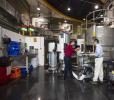Indigenous Kakadu plum farmers attend ANSTO workshop
Indigenous Kakadu plum farmers attend workshop on use and application of the elemental fingerprint technology for indigenous bushfoods provenance.

Showing 181 - 200 of 225 results
Indigenous Kakadu plum farmers attend workshop on use and application of the elemental fingerprint technology for indigenous bushfoods provenance.
Five exceptional female science communicators are part of a larger team who use skills in education and engagement to promote an interest in science amongst the public and students.
MABI instrument can determine both the concentration and source of black carbon pollution in the atmosphere.

ANSTO's Sydney locations are home to the Open Pool Australian Light-water (OPAL) multi-purpose reactor, the Centre for Accelerator Science (CAS), the Australian Centre for Neutron Scattering, the National Research Cyclotron and the National Deuteration Facility.
ANSTO has secured a $1.62 million Medical Research Future Fund (MRFF) grant under the Australian Brain Cancer Mission’s 2024 Brain Cancer Discovery and Translation program

ANSTO has agreed to participate in an Australian trial of a review of research infrastructure access proposals in which applicants remain anonymous to aid the removal of structural barriers to the career progression of Women in STEM.
Accurate ‘fingerprinting’ tool to verify source of origin is in development with collaborators from academia and industry.
Congress marks watershed moment for nuclear medicine and ANSTO

ANSTO has safely managed its radioactive waste for over 60 years. Waste is managed in accordance with national and international standards.

The OPAL research reactor's design and integrated safety features mean it is extremely safe; a fact confirmed by independent analysis.
Modelling and experimentation - a powerful combination in probing mechanical properties of ion irradiated materials through nanoindentation.
Neutron Capture Enhanced Particle Therapy developed at ANSTO.
Report to the independent nuclear regulator, ARPANSA, and the IAEA


ANSTO offers a diverse range of career opportunities within science, engineering, corporate services and trade disciplines.